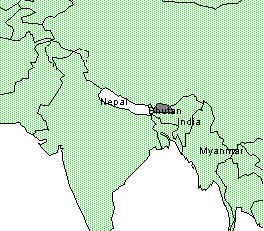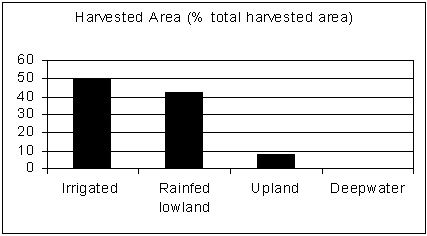General Information
· Main climate: Tropical Highland (> 1 000 m above sea) and Tropical Wet

· Total land area: 4 700 1000 ha
· Internal renewable water resources: 95 km3
· GNP per capita, 1998: PPP$ 1 438
· Main food consumption: Rice, Maize, Wheat, Milk and Fat, Pulses
· Rice supply, 1999:
Basic Statistics
|
|
1985 |
1990 |
1995 |
2000 |
|
RICE |
|
|
|
|
|
Harvested area (T ha) |
32 |
26 |
30 |
30 |
|
Yield (kg/ha) |
1 937 |
1 653 |
1 666 |
1 666 |
|
Production (T t) |
62 |
43 |
50 |
50 |
|
Imports (T t) |
10 |
19 |
24.9 |
NA |
|
Exports (t) |
0 |
0 |
5 |
NA |
|
OTHERS |
|
|
|
|
|
Population (T) |
1 486 |
1 696 |
1 847 |
NA |
|
Agr population (T) |
1 400 |
1 597 |
1 735 |
NA |
|
Irrigated agr area (T ha) |
30 |
39 |
39 |
NA |
|
Fertilizer cons (T t) |
100 |
100 |
100 |
NA |
|
Agr tractors in use (units) |
NA |
NA |
NA |
NA |
Producing Zones and Cropping Seasons
The following table shows the rice-harvested areas in different producing zones.
|
Production Zone |
Harvested area (% total harvested area) |
|
Geylegphug |
18.03 |
|
Samehi |
16.91 |
|
Chirang |
11.72 |
|
Tashignag |
8.49 |
|
Samdrupjogkhar |
7.80 |
|
Punakha |
6.15 |
|
Paro |
5.61 |
|
Wangdiphodrang |
4.80 |
|
Chhukha |
3.53 |
|
Daga |
3.11 |
|
Lhuntahi |
3.07 |
|
Shemgang |
2.96 |
|
Thimphu |
2.92 |
|
Tongsa |
2.30 |
|
Mongar |
1.80 |
|
Pemagatsel |
0.46 |
|
Ha |
0.34 |
Rice is generally planted once a year. The seeding of a nursery bed usually takes place usually in March and April, the transplanting in May, and the harvesting in October.
Production Practices
Rice is grown at altitudes ranging from 150 to 2,400 meters above sea level. Following figure shows the estimated harvested rice area from different rice ecologies during 1995-2000 period

Transplanting is a dominant method of crop establishment in lowland areas. Seedlings used in transplanting are normally raised in a dry nursery bed under rainfed conditions and usually near to farmers' houses for ease of crop care. Many farmers still plant traditional and tall varieties, especially those having red grain, under low input management systems. Rice straw is an important source of feed for livestock in the popular integrated crop-livestock production systems in the country. Recently a number of high yielding varieties were released for cultivation. Frequently planted rice varieties are:
Irrigated ecologies: Cisadane (140 days), MR 84, BG 400-1, BR 153-2b-10-1-3, Bw293-2, IR 20913 -B-26-2-2-3, IR 63, IR 64, Milyang 54, MR 100, MR 101, MR 73, MR 97, N 11
Rainfed lowland ecologies: 00.55/1, 0.026 Expo 80, Attey, Bomteling, Chirang Attey, Chirang Sukhimey, Disobok, Dumja Kaap, Gunja, Kachum, Lumut, Mrah, Ngurmlingboo, Paro Maap, Pasakhachum, Punakha Sakha, Semkaap, Shintila, Shukhimay, Sungpa, Sungsung, Thimphu Maap, Wangdi Kaap, Zechum, Zhakha Kaap
Upland ecologies: Jangkhar and Kamsing
The IR64 has become popular rice variety in the Wangdiphorang-Punakha valley.
Constraints and Issues of Sustainable Production
Low temperatures at high altitude.
Sandy soils with low fertility level.
Weeds, especially Potamogeton distinctus, and blast disease.
Rural poverty.
Inadequate infrastructures, inadequate credit and input supply; and poor transport and distribution systems.
The following table shows the rice production costs.
|
Other information |
Yield (t/ha) |
Cost ($/ha) |
Cost ($/t) |
|
1987 Dry season, irrigated rice at low altitude, |
3.39 |
518 |
152.8 |
|
Dry season, irrigated rice at high altitude |
2.87 |
405 |
141.1 |
The cool night temperatures and high solar radiation at high altitudes are favourable for high rice yield. Appropriate high yielding rice varieties and the application of integrated nutrient management, including the use of chemical fertilizers is required for a sustainable increase in rice production. Both the harvested area and rice yield have remained more or less unchanged; indicating an urgent need for the creation of dynamic rice research and development programmes.
Research and Development Institutes
· Seed Multiplication & Demonstration Farm Bondey, Bondey Trial Farm, Paro,
· Agricultural Research Station, Central Region, Department of Agriculture,
· Centre for Agricultural Research and Development, Department of Agriculture, Wangdiphodrang, Phone: 209, Telex: 890-221 MAGFO TPU BT